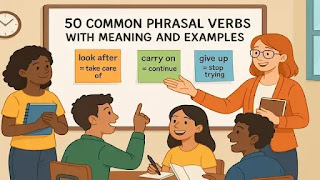What are the 50 Phrasal Verbs with Meaning and Examples?


Public speaking is an essential skill that students need to develop for success both in school and later in life. Mastering this skill not only builds confidence but also enhances communication, critical thinking, and leadership abilities. Below are some of the key public speaking skills every student should cultivate:
Clear speech is crucial for effective communication. This involves pronouncing words correctly, articulating thoughts without mumbling, and ensuring that every word is understandable. When students speak clearly, their audience is more likely to grasp their message without confusion.
Example: A student delivering a presentation in class should pronounce each word clearly to ensure their classmates and teacher understand the content.
Confidence is the cornerstone of public speaking. A speaker who exudes confidence captures the attention of their audience. Confidence comes from preparation, understanding the topic well, and practicing speaking in front of others.
Example: During a school debate, a confident student will present their arguments assertively, making their points more convincing.
Non-verbal communication holds equal significance to verbal communication, as gestures, facial expressions, and body language convey meaning beyond words.Using proper gestures, maintaining eye contact, and having good posture can convey confidence and enthusiasm. Positive body language helps engage the audience and make the speech more compelling.
Example: A student giving a speech can enhance their delivery by using open gestures, maintaining eye contact with the audience, and standing tall.
Good public speakers know how to engage their audience. This can be done through asking questions, incorporating humor, or using stories and examples that resonate with listeners. When the audience feels involved, they are more likely to stay attentive and interested.
Example: A student might ask a question at the beginning of their presentation to grab their classmates' attention and encourage participation.
Monotone speaking can quickly bore an audience. Voice modulation, or varying pitch, pace, and volume, is essential to maintain the audience's interest. Students should practice using an expressive tone that reflects the mood and importance of their message.
Example: A student sharing an emotional story should lower their tone during serious moments and raise it when emphasizing key points.
Effective pacing means speaking at a speed that is neither too fast nor too slow. Pausing at the right moments allows the audience to absorb information and gives the speaker a chance to emphasize key points. Students should practice balancing their speed and using pauses for effect.
Example: A student giving a persuasive speech might pause before delivering their main argument to create anticipation and highlight its importance.
Public speaking isn't just about delivery—it's also about content. Organizing thoughts and preparing an outline is key to ensuring the speech flows logically. Structured speeches are easier to follow and leave a lasting impression on the audience.
Example: A well-prepared student who has practiced their speech will be able to deliver it smoothly without frequent hesitations or getting lost mid-speech.
Public speakers who connect emotionally with their audience are often the most memorable. This requires understanding the audience’s perspectives and addressing their feelings. When speakers show empathy, they build a rapport with the audience, making their speech more impactful.
Example: A student delivering a speech on social issues may use personal anecdotes or stories to evoke empathy from their peers, making the message more relatable and powerful.
Public speakers need to be flexible and adaptable to different audiences and situations. What works for one audience might not resonate with another, so students should be prepared to adjust their language, tone, and delivery based on the audience's needs and reactions.
Example: A student might use more casual language and humor when speaking to their peers but adopt a more formal tone when addressing teachers or parents.
Public speaking is a two-way street. A good speaker also listens carefully to feedback, questions, and audience reactions. This skill helps speakers adjust their presentations in real-time and improve future performances.
Example: In a class discussion, a student who listens attentively to classmates' points will be able to respond thoughtfully, making their contributions more valuable.
Visual aids such as slides, charts, or videos can enhance a presentation by reinforcing key points and making the content more engaging. However, it's important that students know how to use these tools effectively without over-relying on them.
Example: A student giving a science presentation might use diagrams and graphs to explain complex data, making the information easier to understand for the audience.
Mastering public speaking skills is invaluable for students, as these skills build confidence, improve communication, and prepare them for future success in both academic and professional settings. By focusing on clarity, confidence, engagement, and adaptability, students can become more effective speakers and stand out in any setting.
Comments
Post a Comment
Please Don't Enter Any Spam Link In The Comment Box.